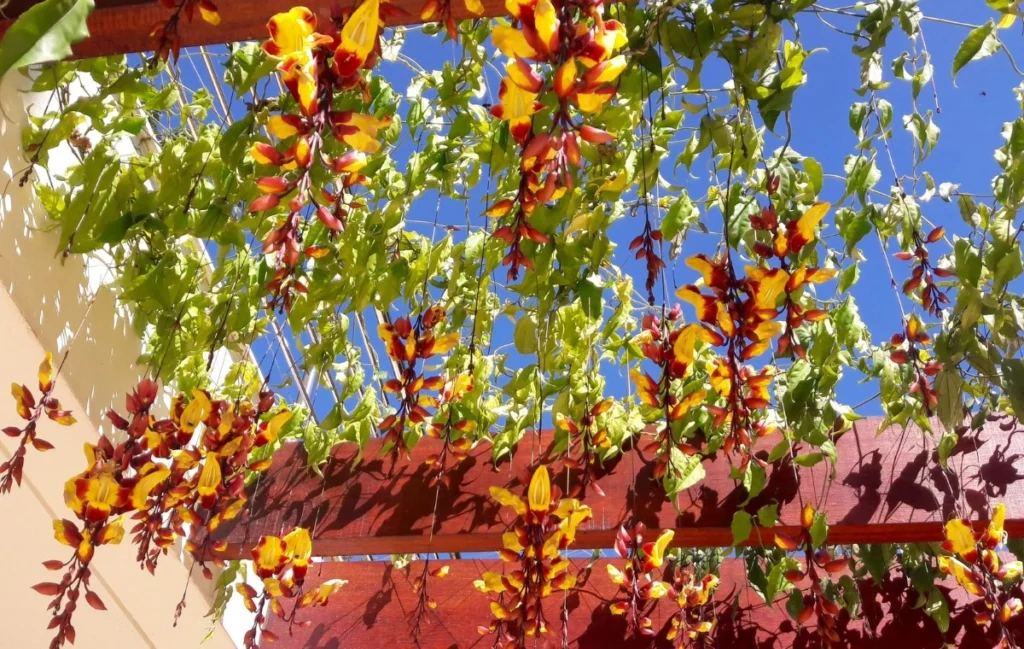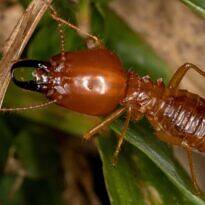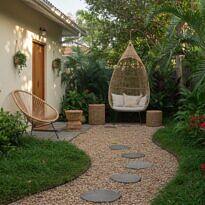The genus Thunbergia is a true box of surprises in the world of ornamental plants. With exuberant flowers and vibrant colors, these beauties are a delight to the eyes and a surefire choice for any landscaping project. After all, besides being beautiful, they are usually low maintenance and very hardy, rarely requiring any care.
But before we explore each of these beautiful thunbergias, do you know why these plants have this curious name?
The genus Thunbergia was named in honor of the renowned Swedish botanist Carl Peter Thunberg (1743-1828), one of the most prominent disciples of Carl Linnaeus, the father of modern taxonomy. Thunberg is widely recognized for his extensive travels and botanical studies, especially in South Africa and Japan, where he documented and classified a vast range of plants and animals. The tribute to Thunberg reflects his significant contribution to botany, highlighting the importance of his work in the development of knowledge about flora. The plants of the genus Thunbergia are, thus, a living tribute to the legacy of one of the great explorers and scientists of natural history.
The Genus Thunbergia: Origins, Family, and Distribution
The genus Thunbergia belongs to the Acanthaceae family and is composed of about 100 species of herbaceous, shrub, and climbing plants. Native to the tropical and subtropical regions of Africa, Madagascar, southern Asia, and the Indian Ocean islands, these plants stand out for their showy and colorful flowers. The wide distribution of the genus Thunbergia is due to its ability to adapt to various climates, from humid tropical forests to semi-arid areas.

In landscaping, these plants are widely appreciated for their versatility and beauty, being used in vertical gardens, living fences, covering pergolas, and as ornamental plants in pots and flowerbeds. Thunbergias are especially valued for their ability to attract pollinators such as butterflies and hummingbirds, contributing to the biodiversity in the gardens where they are cultivated. Let’s explore the peculiarities and curiosities of eight species that can transform your garden into a true paradise.
Oh, and then tell me which ones you already knew and which ones are new to you.
1. Black-eyed Susan – Thunbergia alata
The Thunbergia alata, or Black-eyed Susan, is a cheerful climber that doesn’t ask for permission to grow wherever it is sown. Its flowers, which appear in profusion, are usually vibrant orange or yellow, although there are cultivars of other colors. But what really catches the eye is the dark brown center that resembles a curious and charming eye.

- Origin: East Africa
- Growth: Grows as if in a hurry to embrace the world, reaching up to 3 meters (10 feet) in height. Ideal for light supports such as trellises, screens, and fences that need a touch of color. It is also great for disguising rubble and strange views, growing quickly and hiding the mess.
- Flowering: Blooms abundantly during spring and summer, as if celebrating life in grand style.
- Sun Exposure: Loves full sun but accepts partial shade without complaining, although it blooms less in these situations.
- Curiosity: Attracts butterflies and bees, bringing dynamism and extra interest to your garden.
Cultivation Tips
Plant it in well-drained soil and water regularly. Fertilizing during the growing season helps keep this lady blooming intensely. Over time it can become quite tangled and lose some of its beauty. But that’s okay, it can be used as an annual plant without any problems. It’s one of its talents!
Have you ever thought of having a curtain of smiling flowers in your garden? Try Black-eyed Susan and make your space more cheerful!
2. Bengal Clockvine – Thunbergia grandiflora
The Thunbergia grandiflora, or Bengal Clockvine, is a majestic climber that brings the sky closer to you. Its large flowers in delicate blue-lilac with a yellow center are true works of art of nature, hanging in graceful clusters. There is also a variety of the plant with white flowers.

- Origin: India and Sri Lanka
- Growth: Can reach an impressive 10 meters (33 feet), perfect for covering large structures such as walls, pergolas, and arbors, and creating a vertical spectacle.
- Flowering: Blooms during summer and autumn, but always a flower here and there throughout the year, filling your garden with the tranquility of blue at any time (except in very cold climates).
- Sun Exposure: Prefers full sun but is flexible and adapts to partial shade.
- Curiosity: In traditional medicine, it is well known for treating various conditions, showing that beauty and utility can go hand in hand. In addition, its flowers are considered edible and are said to taste like mushrooms, adding flavor to different culinary preparations.
Cultivation Tips
Adapt it to fertile, well-drained soils, water with care, and fertilize to promote lasting and abundant flowering. Pruning helps control its growth and stimulate new blooms.
Have you ever imagined contemplating a waterfall of blue flowers? Bengal Clockvine can make that dream come true!
3. Mysore Trumpet Vine – Thunbergia mysorensis
One of the favorites among landscapers, the Thunbergia mysorensis, known as Mysore Trumpet Vine, is a breathtaking plant. Its red flowers with yellow petals resemble enchanted slippers ready to dance in long hanging clusters. Perfect for being viewed from below.

- Origin: India
- Growth: Can reach up to 6 meters (20 feet), it is valued in pergolas, arbors, and arches, creating a fairy-tale setting.
- Flowering: Blooms year-round in tropical climates, with a special show in spring and summer.
- Sun Exposure: Needs full sun or partial shade to show all its splendor.
- Curiosity: Hummingbirds are unconditional fans of this plant, transforming your garden into a meeting point for these little birds.
Cultivation Tips
Provide fertile, well-drained soil, water regularly, and fertilize to maintain a good production of flowers.
How about transforming your pergola into a magical setting with Mysore Trumpet Vine? Where would you plant it?
4. Scarlet Clock Vine – Thunbergia coccinea
The Thunbergia coccinea, or Scarlet Clock Vine, is a miniature version of its more famous cousin, but no less charming. Its red flowers in delicate clusters are like small whispers of life in the garden.

- Origin: India and Sri Lanka
- Growth: Reaches up to 3 meters (10 feet), perfect for gardens in small spaces that do not dispense with a touch of color and fantasy.
- Flowering: Blooms in spring and summer when the heat inspires its vibrant colors.
- Sun Exposure: Prefers full sun or partial shade, adapting gracefully to different light conditions. It is important to note that the more light and heat, the more intense the red color of its flowers.
- Curiosity: Despite its beauty, it is less demanding, a great choice for beginner gardeners or those with little time.
Cultivation Tips
Well-drained soil, constant moisture, and a bit of fertilizer in spring will ensure a happy and flowering plant.
How could Red Thunbergia add a touch of life to your garden?
5. Bush Clock Vine – Thunbergia erecta
The Thunbergia erecta, known as Bush Clock Vine or King’s Mantle, is a perennial and branched shrub with dark leaves, ideal for bringing the grace of thunbergias not only to supports but to the rest of the garden. Its deep blue flowers with a yellow throat create a hypnotic contrast.

- Origin: West Africa
- Growth: Can reach 1.5 meters (5 feet) in height, ideal for forming hedges and borders that defy monotony.
- Flowering: Blooms throughout the year in tropical climates, a constant gift for the eyes.
- Sun Exposure: Prefers full sun or partial shade, adapting elegantly. For hedges or topiary shrubs, the ideal is cultivation under full sun to stimulate the plant’s density and a fuller appearance. Don’t forget to prune occasionally to allow the plant to bloom.
- Curiosity: Besides its beauty, it is traditionally used to treat skin infections, showing that it also takes care of those who cultivate it.
Cultivation Tips
Plant in fertile, well-drained soil, water regularly, and fertilize to keep it always elegant and blooming.
Have you ever thought of forming colorful hedges in your garden? Bush Clockvine would be a good choice.
6. White Lady – Thunbergia fragrans
Thunbergia fragrans, known as the White Lady or Sweet Clock Vine, is a climbing plant that brings with it the mystery and purity of starry nights. Its white and fragrant flowers invite moments of contemplation.

- Origin: India, Malaysia, and Sri Lanka
- Growth: Reaches up to 16 feet (5 meters) in height, perfect for covering fences and pergolas with a blanket of flowers.
- Blooming: Blooms mainly in summer and autumn, when its fragrance spreads through the night.
- Sun Exposure: Prefers full sun or partial shade, blooming best with some sun’s warmth.
- Interesting Fact: Its fragrant flowers are more intense at night, making it an excellent choice for nocturnal and romantic gardens.
Growing Tips
Well-drained soil, constant moisture, and regular fertilization will make this plant a star in your garden.
Do you appreciate nocturnal gardens? Where would you plant the White Lady to enjoy its fragrance at night?
7. Orange Clock Vine – Thunbergia gregorii
Thunbergia gregorii, or the Orange Clock Vine, is a climber that seems to have captured the sun in its flowers. Its bright orange petals are a true spectacle of color that does not go unnoticed. The Orange Clock Vine is still somewhat rare in landscaping compared to its relatives described earlier but has great potential as an ornamental plant.

- Origin: West Africa
- Growth: Can grow up to 6.5 feet (2 meters), suitable for covering fences and trellises, bringing the warmth and joy of the color orange.
- Blooming: Blooms in spring and summer, completely changing the garden’s temperament with its cheerful colors.
- Sun Exposure: Prefers full sun but tolerates partial shade.
- Interesting Fact: Unlike many others of the genus, it is not invasive and is easy to control, a plant that knows its place.
Growing Tips
Plant in well-drained soil, water regularly, and fertilize in spring for intense blooming.
Do you prefer low-maintenance plants? The Orange Clock Vine can simplify your garden without losing beauty.
8. Blue Glory Vine- Thunbergia battiscombei
Thunbergia battiscombei, known as Blue Glory Vine, is a climber that seems to come out of a dream. Its blue-violet flowers with a white center are as intense and elegant as they are unusual. Still rare to see in garden centers, this charming climber has all the characteristics to conquer gardens.

- Origin: Tropical Africa
- Growth: Can grow up to 10 feet (3 meters), perfect for trellises, fences, pergolas, and arbors.
- Blooming: Blooms during summer and autumn, bringing color and elegance to hot days.
- Sun Exposure: Prefers full sun or partial shade.
- Interesting Fact: Less known in landscaping, it is a rare gem that can make your garden unique.
Growing Tips
Well-drained soil, constant moisture, and spring fertilization will promote vigorous growth and exuberant flowering.
Do you enjoy discovering less common plants? Blue Glory could be the perfect addition to your garden.

Species of the genus Thunbergia are like the stars of a show, each with its unique brilliance and charm. From the vibrant flowers of the Black-eyed Susan to the celestial elegance of the Blue Glory, these plants are an invitation to an enchanted garden.
Adding Thunbergia to your green space not only enriches the aesthetic but also brings life and movement with the presence of pollinators such as butterflies and hummingbirds. Each species has its particularities, but all share the power to transform your garden into a refuge of beauty and tranquility.
Which of these charming Thunbergia species would you like to see blooming in your garden?
May these enchanting plants bring color, life, and a touch of poetry to your green space.







